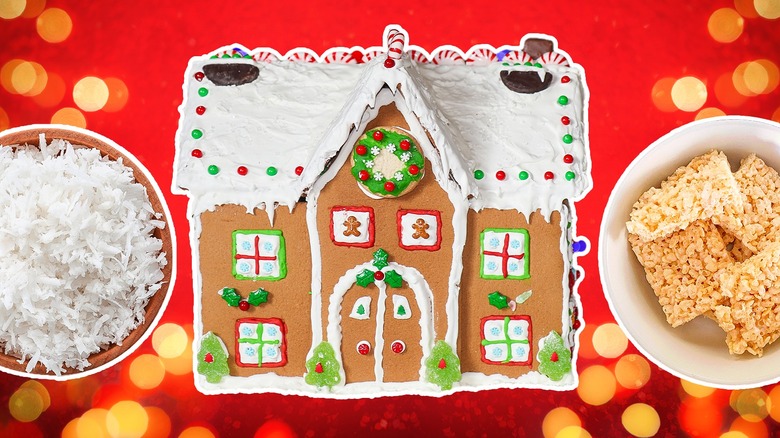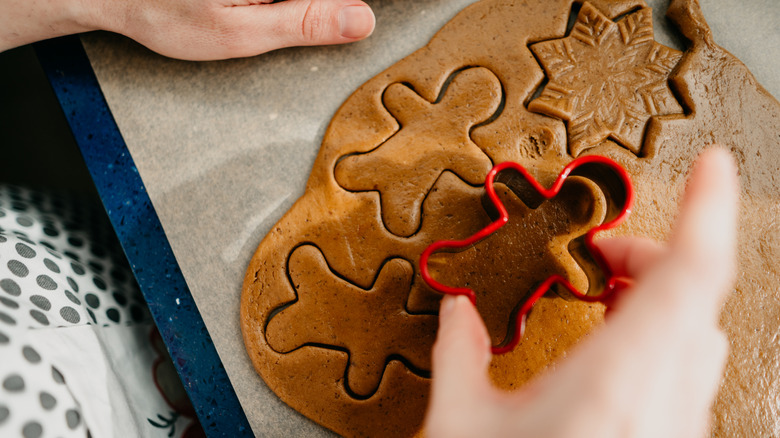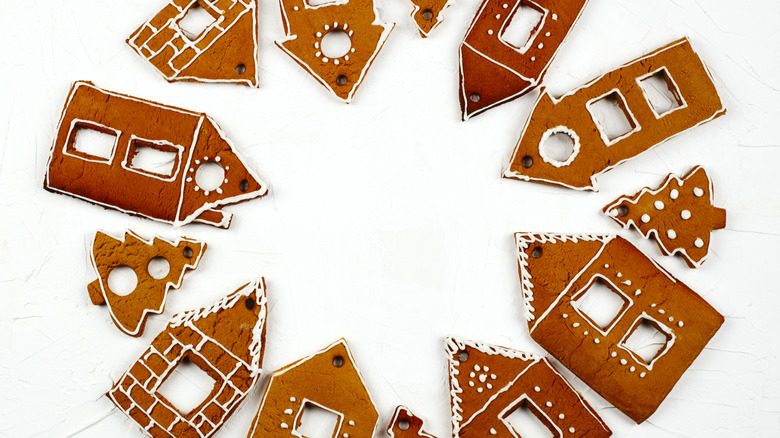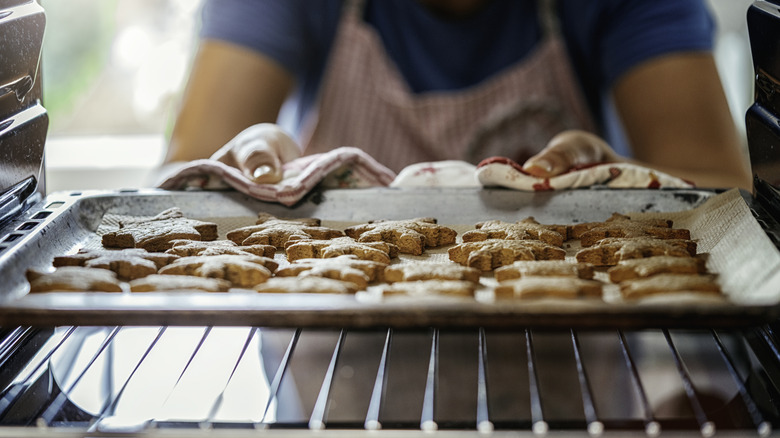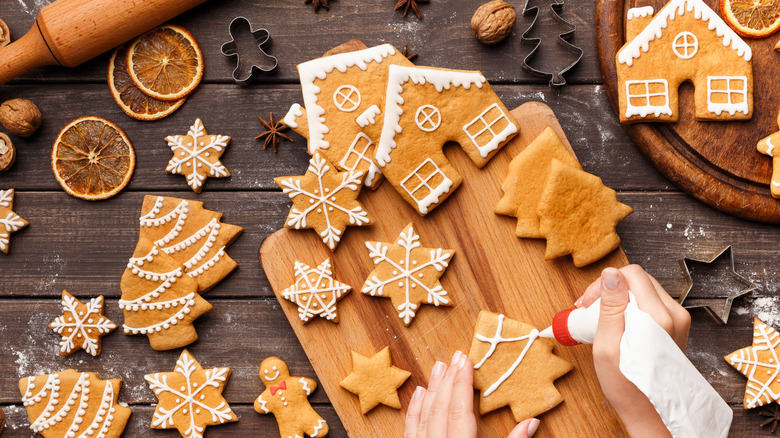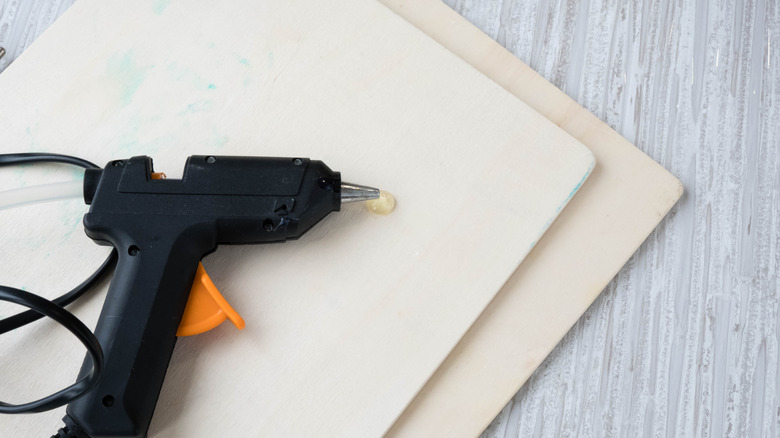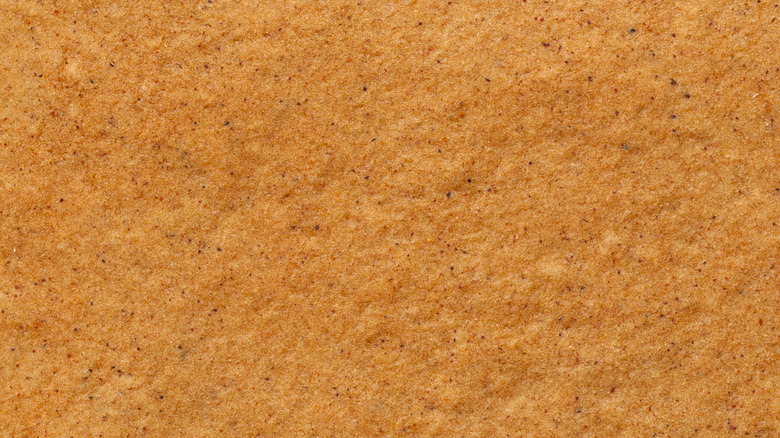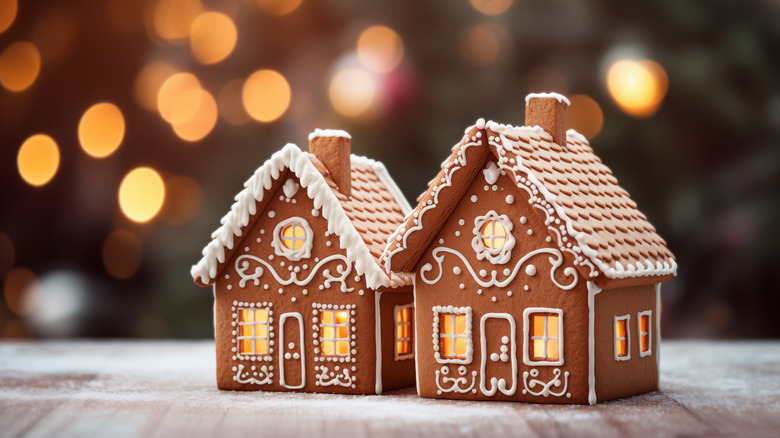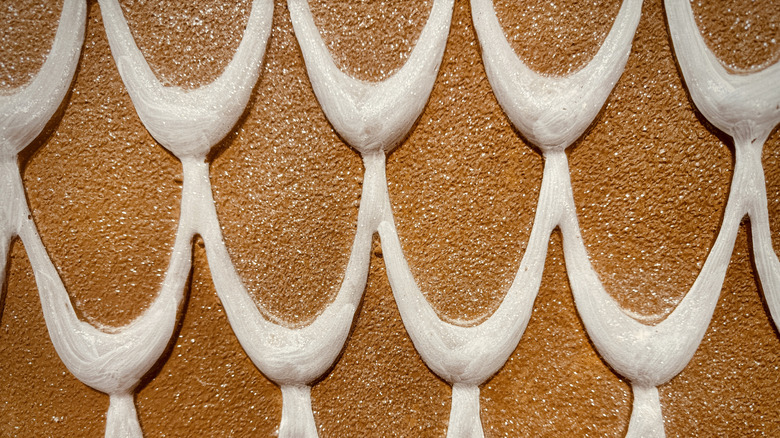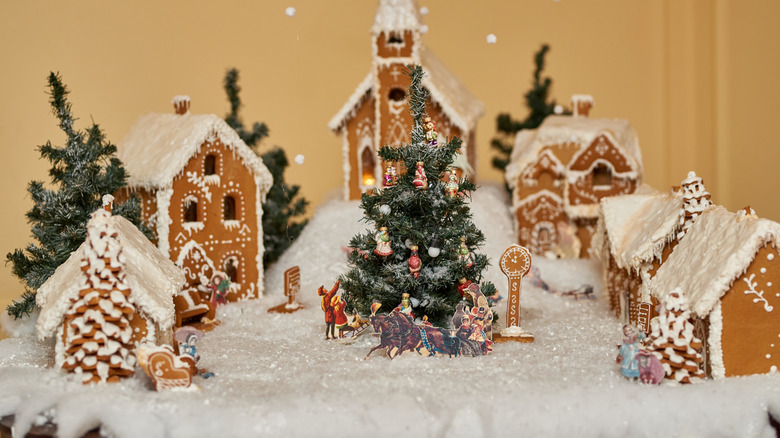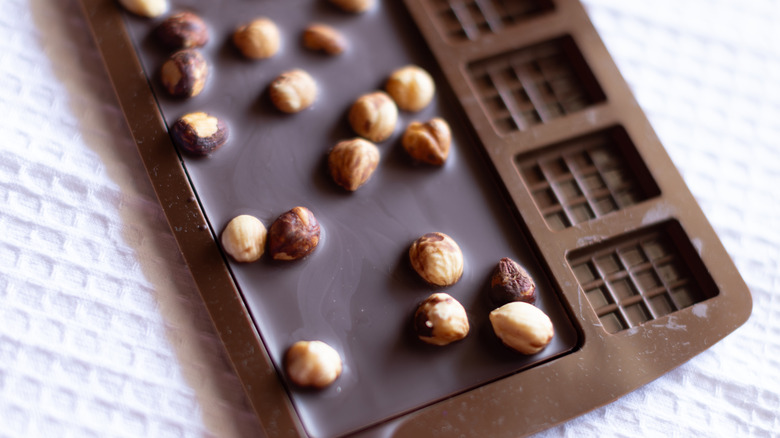How To Take Your Gingerbread House To The Next Level
Holidays are a time for gathering with family, watching the snow fall, and enjoying some time off work to spend on fun baking projects. From chewy chocolate chip cookies to flaky apple pie, there are so many good options worth turning on the oven for, but none are more festive than a classic gingerbread house. Homemade gingerbread can be dressed up and down in so many ways to suit any kind of vision you might have in mind. This type of baking borders on art, and is a great way to pass an evening while stretching your imagination.
We spoke to a few master gingerbread architects to discover some ways to create a better gingerbread house this holiday season. They gave us some killer secret tips for creating jaw-dropping, show-stopping gingerbread creations that you won't have the heart to toss once the season is done.
Bake your gingerbread properly
Before you even start building a gingerbread house, you have to have solid construction materials. Making the dough the correct way sets up the building blocks for your house to be sturdy and ensures you won't have issues with structure down the line. Chef Flora Aghababyan, Chief Cake designer at the Wynn Las Vegas, walked us through some of her tips for baking better gingerbread. "Prioritize scaling out your ingredients," advises Aghababyan. "Weighing ingredients can help avoid the structure of the gingerbread house from looking uneven and prevents the house from falling."
After adding all the ingredients into the mixture, "be sure the dough is well mixed with no dry spots. Expect the texture to be firm and slightly tacky." There should be no major air bubbles that could create weak spots once baked. After the dough is made, give it a good rest before rolling, shaping, or baking it.
Freeze the dough before baking to minimize spread
Cookie spread can be a huge issue when it comes to making gingerbread houses. After you go through all the trouble of rolling and cutting your gingerbread house pieces to fit into the grand design, the last thing you need is the dough spreading unevenly and causing difficulties.
Amway Grand Plaza's Gingerbread Architect, Executive Pastry Chef Doug Orr, suggested to "Refrigerate or freeze your gingerbread dough before cutting it to template size. Cold dough is much easier to cut when chilled." Once the dough is cooled from the freezer, it's the perfect time to cut the pieces to the correct shape and size — and to make sure the dimensions are correct, you'll need to do this with purpose. "Always start with a sturdy template, like a cardboard model," said Orr. "Tape the cardboard pieces together to guarantee a precise and secure fit."
Bake the cookie low and slow
Think a hot oven will make the best gingerbread house? Think again. Oven temperature can make a big difference to cookies and, as Doug Orr explains, the name of the game is drying out the cookie dough to a crisp, sturdy consistency that won't bend or break under its own weight. "Bake the gingerbread at a lower temperature for a longer time than usual," says Orr. This will dry it out slightly to ensure it's sturdy enough to both assemble and decorate.
The optimal temperature is less than 350 F (Flora Aghababyan recommends 320 F), and this lower temperature allows the dough to bake evenly, preventing any soft spots that could weaken the structure. Before you throw the dough onto a sheet pan, try adding an extra layer of protection. Using parchment paper or silicone mats while baking ensures the gingerbread doesn't stick, preserving its clean edges. Let the pieces cool completely before assembly, to maintain their shape and integrity. You can also leave the pieces in the oven after you turn it off to cool down so the pieces dry out even more.
Perfect your royal icing
When making a gingerbread house, the right type of frosting is one of the most important elements of the entire craft. As Doug Orr, says, "A properly made royal icing works as the perfect glue." Getting the texture and consistency right can make or break your gingerbread house; Flora Aghababyan recommends using "a thick royal icing to build the house so all the elements stick together."
Royal icing is a simple mixture of powdered sugar and egg white, or powdered meringue. Orr's recipe uses three ounces of egg whites for every pound of powdered sugar, plus 1½ tablespoons of cream of tartar. You can easily adjust the consistency to suit your needs by adding more sugar or thinning it out with a touch of water. Make sure to keep your royal icing stored correctly, to prevent it drying out. Orr also mentions that you can "re-whip icing every 20 minutes to incorporate air and to keep it fluffy."
Use hot glue as your secret weapon
If you don't mind using a little assistance when assembling your gingerbread house (we won't call it cheating), a hot glue gun can make a huge difference. Once your house's walls and roof pieces are decorated and dry, you can join them together with some thick lines of hot glue. This trick works great for putting pieces together because it's easy to apply and dries quickly.
Keep in mind that this method does make the house inedible but most people won't be nibbling on their gingerbread houses anyway. If you want, you can use the hot glue just for setting up the walls and roof, and keep royal icing for all the decoration and candy sticking. If you need a little extra support when waiting for the walls to dry, a few cans from your pantry work nicely as temporary support columns.
Mist the dough before sprinkling with crystal sugar
Another brilliantly obvious (but not too obvious) tip from Doug Orr is to spritz things with water before you start construction. "Mist the gingerbread lightly with water and sprinkle in an even layer of crystal or granulated sugar on the surface," he recommends. "This creates a rough finish, allowing the royal icing to stick more effectively than a smooth surface." This tip is simple but oh-so-effective. As a bonus, the sugar has the added benefit of giving your gingerbread pieces the look of ice crystals or a fresh dusting of Christmas snow.
If you don't have any sanding or crystal sugar on hand but still want to give your cookie some texture, try scraping the sides or edges with a microplane. This will rough the surface up a little, which will also give it a texture that's easier for royal icing to adhere to, giving the joints more than just a superficial connection.
Give the house crystal clear window panes
Creating realistic windows for your gingerbread house can give it such a festive and realistic look. One way to achieve this is to use crushed Jolly Ranchers to make colorful, stained-glass windowpanes. Simply place the crushed candy into the window cutouts of your gingerbread before baking, and the heat will melt the pieces into a smooth, glossy finish that hardens as it cools.
For a more transparent, frosted-glass effect without using the oven, sheets of gelatin can be very effective, and these PerfectaGel Gold Gelatin Sheets are an excellent choice. Cut the gelatin to fit the window openings and attach it using royal icing after baking. This method creates a delicate, almost frosty appearance, ideal for a wintry theme. Both options are edible, versatile, and add a charming, professional touch to your gingerbread house. Before you finish enclosing the house, put a string of remote-controlled fairy lights inside to give your house a welcoming festive glow.
Decorate the walls and roofs before assembling them
When constructing a gingerbread house, you never want to struggle to fight gravity. For the best results, always decorate the walls and roof pieces before assembling the structure. This approach makes it easier to add intricate designs, piping, and details without worrying about stability or awkward angles. It can help to lay the flat pieces on a sturdy surface and secure them in place with a bit of tape or a non-slip mat to keep them steady while you work.
Once the decorations are complete and the icing has completely dried, assembling the house becomes a breeze. This method not only ensures cleaner lines and fewer smudges, but also reduces the risk of damaging the structure during the decoration process. You can always add more decorations and candies to the house later if you want even more adornments, giving you more flexibility to enhance its design than you would be able to pull off if decorating the house after it's already built.
Dessicated coconut makes for the best fake snow
When it comes to creating a picture-perfect gingerbread house, the snowy landscape is just as important as the house itself. For a realistic, charming effect, desiccated coconut is your best option for fake snow. Unlike powdered sugar, which can absorb moisture and clump over time, desiccated coconut retains its fluffy texture and pristine appearance, making it ideal for decorating. As well as its fine, powdery consistency, it also has a slight natural shine to add a touch of sparkle.
To use this tip, simply sprinkle it over a layer of royal icing or melted white chocolate to secure it in place. You can also use it to create snowdrifts along the edges of your gingerbread house or as a finishing touch on the roof. Not sure where to start? Set your finished gingerbread houses in a rimmed baking sheet, then fill in coconut "snow" around them.
Make your own custom candy decorations
Flora Aghababyan's advice for an out-of-this-world gingerbread house is all in the decoration. A creative way to start conversations with your friends and family is to make your own candy to decorate your gingerbread house because, as Aghababyan says, "What's more unexpected than making your own candies?" Homemade candy is an awesome way to incorporate design elements into your gingerbread house that no one will have seen or used before.
Handmade and homemade gingerbread houses are all about challenging yourself as a baker, so this is a great way to expand your horizons. With a little imagination, dark chocolate salted caramel squares could become stepping stones while Christmas wreaths made from cornflakes could adorn every window and door. Even some simple chocolate melted and set in a mold with crushed nuts could be reimagined as a rock-clad fireplace or rustic garden wall.
